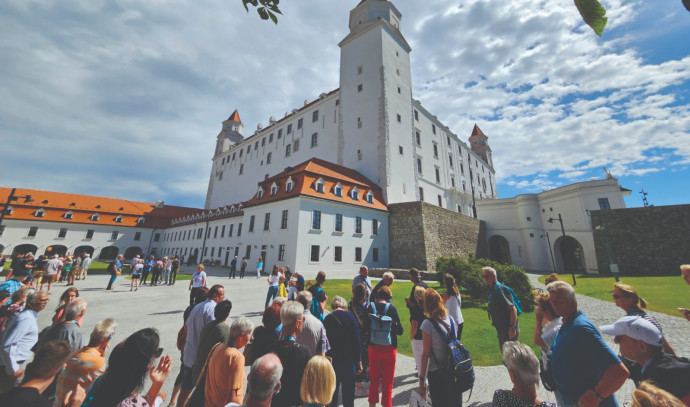As capital cities go, Bratislava is extremely compact, which means most attractions are easily walkable and well worth visiting.
The largest Slovakian city boasts two castles, the grave of famed rabbi Chasam Sofer, and a UFO permanently hovering over the mighty Danube.
Perhaps the best way to get to know the city is via one of the many “trains” and old-world omnibuses that ferry tourists around town, with explanations in numerous languages including English, Esperanto, and a child-friendly version of Slovak.
Nearly all the colorful vehicles all make a stop at Bratislava Castle, the city’s highest point, offering wonderful views of the Danube, Europe’s second-longest river. Archaeological evidence suggests the castle site has been inhabited for almost 5,000 years with the current structure the result of decades of reconstruction work in the 20th century.
Devin Castle lies a short drive out of town but can also be reached by a leisurely hour-long sail along the Danube or via a riverside bike trail. The fortress overlooks the confluence of the Danube and Morava rivers.
As with many attractions in Slovakia, the castle has a tumultuous history both in the Middle Ages and also during the lifetime of many readers of this item. It dates back to 864 and passed from one family to another as ownership of this area moved from kingdom to empire and back again down the years.
But it was the castle’s strategic position in the second half of the 20th century that attracts many of today’s visitors. Just below, the opposite banks of the Danube and Morava are in Austria. During the Communist period, this was one of the sites where those living in the East attempted to cross to the West.
It’s easy to understand why – the Morava, in particular, is narrow here. Timing it right, when guards were looking the other way, one could be in Austria in a few strokes of the water. However, several poignant monuments on the waterfront point to those who didn’t make it to the West – both here and elsewhere across Europe.
Below the castle is tiny Devin village, where local hostelries serve up unique berry wines – almost like classic kiddush wine but with a slightly sour aftertaste.
And Devin is also the name of one of many excellent local wines, with a focus on the whites. There is excellent dining to be had in Bratislava. The focus is on Central-European dishes, and one particular favorite is haluski, tiny gnocchi-like dumplings, topped with Bryndza cheese (if bacon isn’t your thing, make sure to ask for it bacon free).
One place there is no bacon is in the relatively new Jewish community center. There are only a few hundred Jews in the city. The JCC offers them highly subsidized kosher meat meals, served up by Israeli Boaz Raz. At the time of writing, Raz is opening Sababa, a kosher meat restaurant in the heart of the city (next to the Crowne Plaza Hotel), which will serve up Israeli and Slovak dishes.
The JCC also has a small synagogue, where services are held most of the year. The city’s only surviving pre-war synagogue is the impressive cubist building on Heydukova Street. The shul only opens for prayers on the High Holy Days and on very special occasions because heating costs are simply too high.
But the building is open to visitors on Sunday and Fridays and includes a small museum about the synagogue’s design, the country’s Jewish community, and an explanation of Jewish customs via a collection of artifacts.
The former ghetto lies a 10-minute walk away. En route, look out for a series of plaques dedicated to influential members of the city’s Jewish community such as Imre “Imi” Lichtenfeld.
Together with friends, he defended the local Jewish community with his body against antisemitic attacks by fascist gangs in the late 1930s. Lichtenfeld is better known though as the inventor of krav maga, a martial art he developed after he reached Palestine in 1942.
HE IS not the only Jewish athlete celebrated in Bratislava. The state-run Museum of Jewish Culture recently opened a beautifully curated and designed temporary exhibition about the community’s champion swimmers of yesteryear and today.
There are big plans for the museum, which is housed in a building that was part of the Bratislava Ghetto. Currently, the remainder of the museum looks at Jewish life via items collected from across the country and also recounts Jewish printing prowess with a particular focus on the works of local rabbinic great Rabbi Moses Schreiber, the Chasam Sofer.
Before heading to Schreiber’s unique grave, a brief walk along the city wall, past more descriptive boards dedicated to Jewish city heroes, brings you to the memorial to the 105,000 Slovak Holocaust victims.
The sculpture, symbolizing an abandoned house with the Star of David on the top, was placed on the site of a Neolog synagogue, destroyed not during World War II but rather by Communists, who demolished the area to pave the way for a major road that cuts through the city.
Fascists also destroyed parts of the city’s heritage in the name of “progress.” The Chasam Sofer, who lived in the 18th and 19th centuries, was the rabbi of what was then Pressburg, created the famous Pressburg Yeshiva, and was a major opponent of the fledgling Jewish Reform movement. He was buried in the city’s Jewish cemetery in 1839.
Just over a century later, Slovak leader Jozef Tiso decided to build a road tunnel under Bratislava Castle – a thoroughfare that would be routed through the cemetery. Lengthy negotiations and rumored cash payments led to Tiso agreeing to exhume most of the bodies to a newer Jewish cemetery but leaving the graves of Schreiber and two dozen other rabbis untouched, under the road subsequently replaced by a tram line.
Today there is a modern memorial to the Chasam Sofer. All that is visible above ground are dozens of glass panels. With prior arrangement, one can go underground to see the graves. Those panels reach down into the subterranean concrete cemetery. Hundreds of prayer notes are scattered around Schreiber’s grave in the hope that he will act as intercessor for all the wishes. The structure includes a prayer hall.
Bratislava may be small but there is a lot to take in – besides the sites, there are fine theaters, fascinating buildings from so many periods, and the wonderful out-of-town Danubiana museum of modern art.
Perhaps the best way to end a trip to the city is to ascend into the UFO. This 95-meter tower, observation deck, and fine-dining restaurant, shaped like our perception of a UFO, affords the best public view of Bratislava and its environs. The vistas take in vast stretches of the Danube, the Little Carpathians, the Alps (on a clear day), and into Austria and Hungary.
But perhaps the most important view to take home is that of Bratislava itself – the castle, ever dominant, overlooking this small city packed with history, culture, great food, and anything else you would expect from a much-larger European capital.
The Bratislava shul docent saved during Holocaust
Just a glance into Ivan (Ilan) Pasternak’s slate-blue eyes tells you he has experienced times good and bad during his 81 years. He takes visitors around the 100-year-old cubist Heydukova Street Synagogue in the heart of Bratislava – the only shul to survive the Holocaust.
His last stop on the tour is on the bimah – the central raised area from where prayers are chanted and the Torah is read. Beyond explanations about the architecture, community and liturgy, he has two stories to tell…
Money for escape
When Pasternak was one, in 1944, he was deported with his parents. They were separated, his father via various camps to his death in Dachau, while he and his mother were sent to a Slovakian camp.
His enterprising mom called over some guards and asked if they had a knife. Surprised, they produced a sharp blade. She asked them to cut the collar on baby Pasternak’s shirt.
As they slit the material, a wad of banknotes fell out. Money for escape. The guards agreed to turn a blind eye.
As they headed out of the camp right towards a bar, she went left and into the woods. She and her baby were looked after by a Slovak family until the war’s end.
Never forget
The bimah was moved to a corner of the synagogue during World War II, as was the rest of the furniture. The fascists and Nazis used the empty space to house furniture from Jewish homes.
After the war, the shul furniture was repositioned, including the wooden table on the bimah. All looked back to normal.
At this point in his tale, Pasternak pulls back the green velvet table cover to reveal a fading swastika. He pauses and looks at the synagogue visitors with those slate-blue eyes and says:
“Whenever we had a bar mitzvah down the years, we would tell the bar mitzvah boy to never forget and, that despite everything, we are still here.”
Mark and David host The Jerusalem Post Podcast – Travel Edition (https://www.jpost.com/podcast/travel-edition). They were the guests of the Bratislava Tourist Board.



